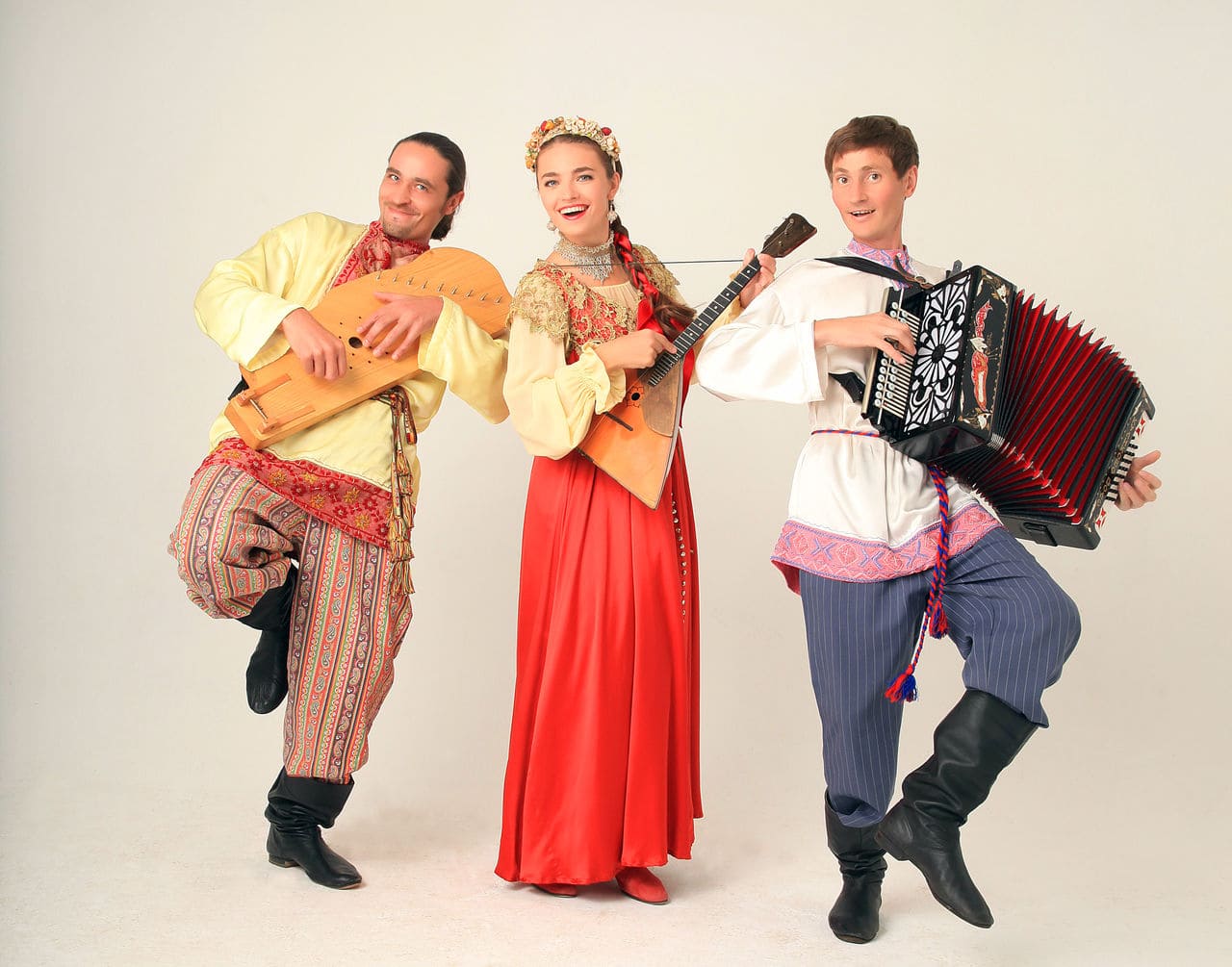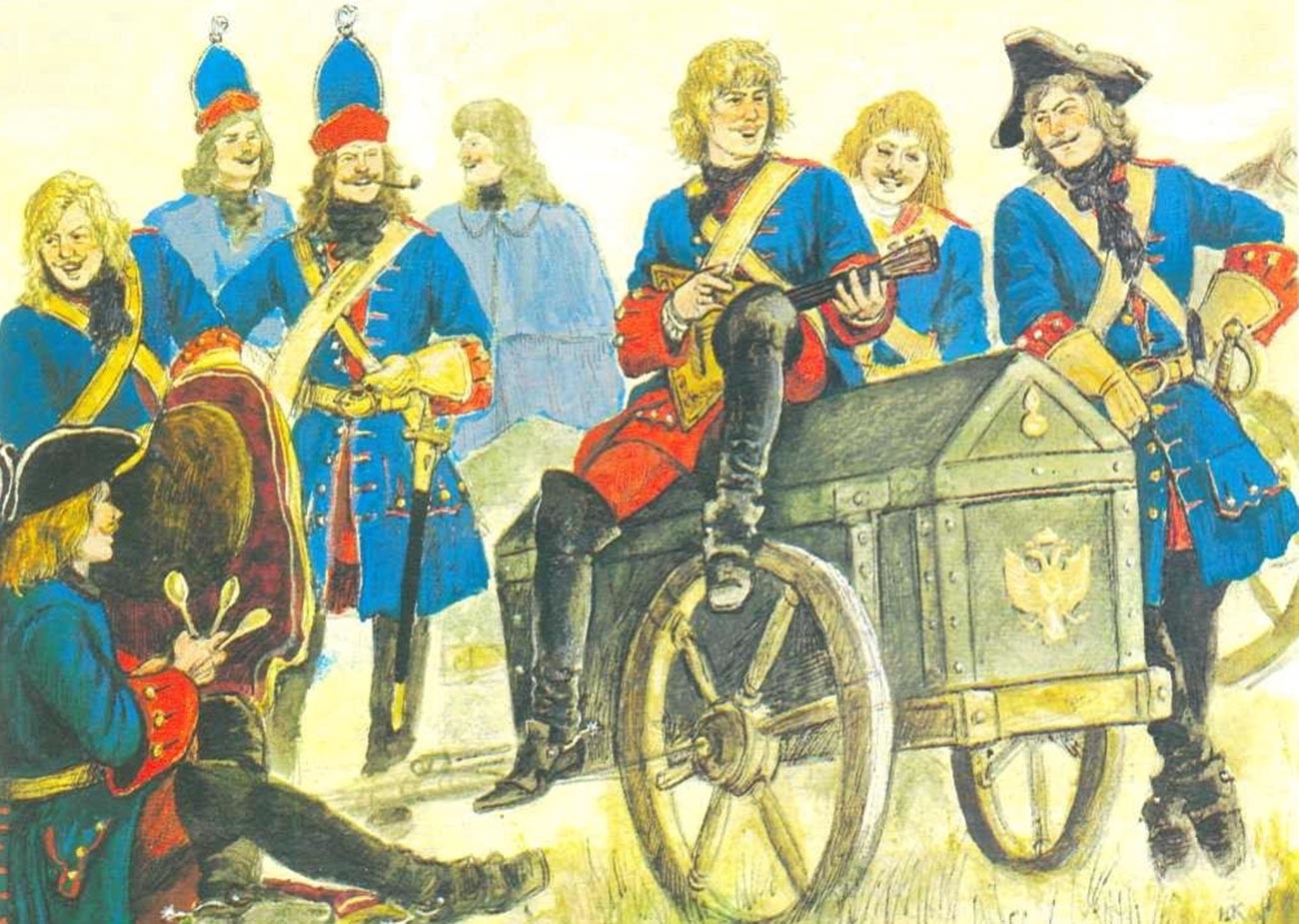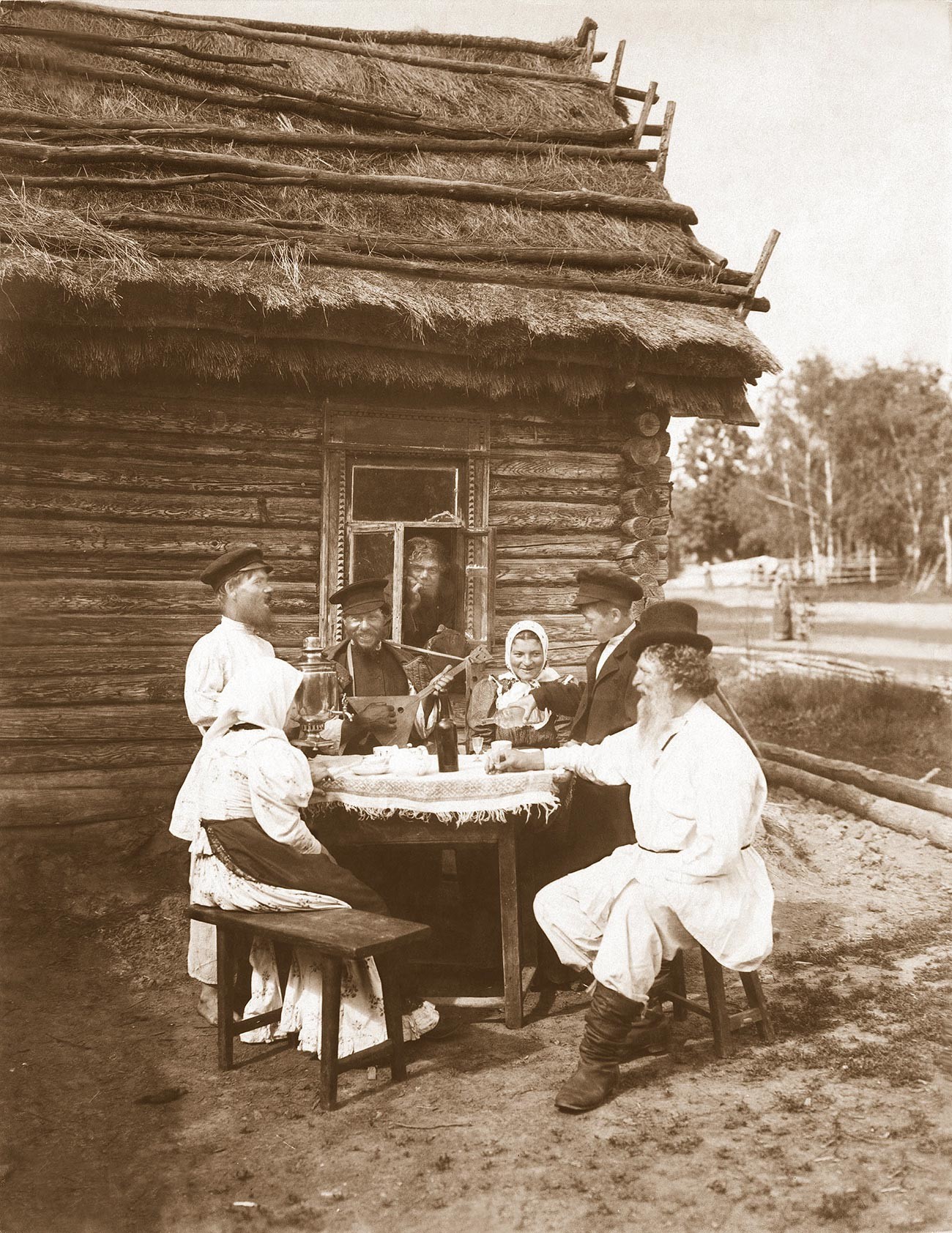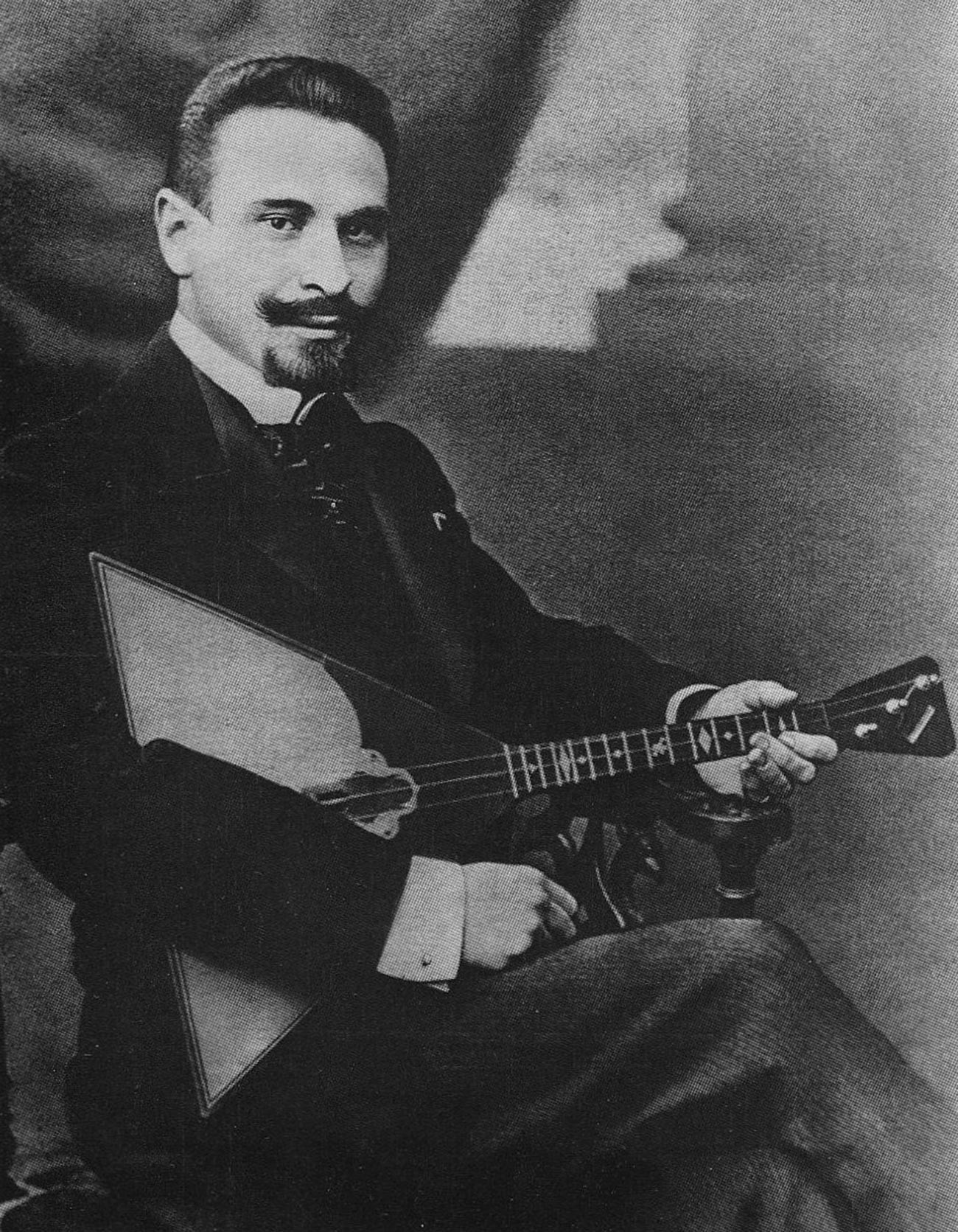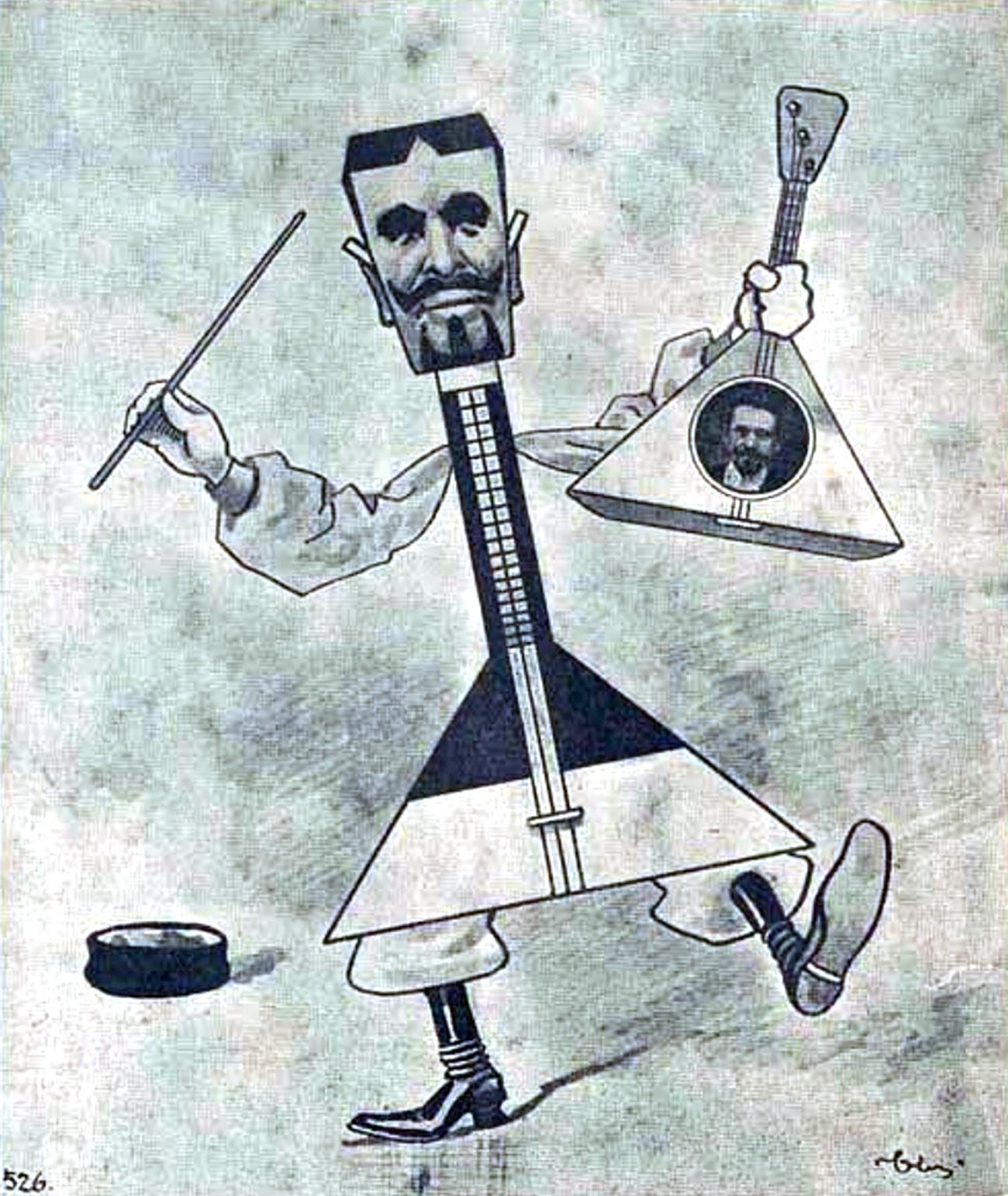When we listen to the Russsian folk music we can hear some unique sounds of traditional musical instruments. Russian folk orchestras usually consist of balalaikas, domras, gusli, bayans, garmons, bubens and even Russian seven-stringed guitars (semistrunkas).
The balalaika is a Russian plucked string musical instrument. It has a triangular wooden body and three strings on its long neck. The strings are normally plucked with fingers. The balalaika is made in six different sizes. The instrument was developed in the 18th century from the domra, a three-stringed lute played in Russia and Central Asia. The balalaika was a popular village instrument with peasants who played music, danced and sang some folk limericks. In 1889 at the World Exhibition in Paris, Russia organized a folk orchestra performance. That’s when the balalaika became a world-famous Russian instrument and one of the most recognizable symbols of Russia.
Перевод
Когда мы слушаем русскую народную музыку, мы слышим уникальные звуки традиционных музыкальных инструментов. Русские народные оркестры обычно состоят из балалаек, домр, гуслей, гармони, бубнов и даже русских семиструнных гитар (семиструнок).
Балалайка – это русский щипковый струнный музыкальный инструмент. Он имеет треугольный деревянный корпус и три струны на длинном грифе. Струны, как правило, защипывают пальцами. Балалайку изготавливают в шести различных размерах. Инструмент получил свое развитие в 18-м столетии от домры, трехструнной лютни, на которой играли в России и Центральной Азии. Балалайка была популярным деревенским инструментом среди крестьян, которые на ней играли, плясали и пели народные частушки. В 1889 году на Международной Выставке в Париже Россия организовала представление народного оркестра. Именно тогда балалайка стала всемирно известным русским инструментом и одним из наиболее узнаваемых символов России.
Традиционный народный музыкальный инструмент. (Russian folk musical instruments) — 4.4 out of
5
based on
5 votes
When did balalaikas first appear, who played them and, most importantly, still play them? Here’s all you need to know about the balalaika.
When did the balalaika first appear in Russia?
Historians differ on when exactly the balalaika first appeared in Russia. The first written records mentioning it date back to 1688-1700, during Peter the Great’s reign. In his book Anecdotes from the Life of Peter the Great, historiographer Jacob von Staehlin wrote that Peter “had no chance to hear anything other than the rough sound of drums, a field flute, a balalaika, a shepherd’s horn and a Ukrainian bandura”.
Peter grew fond of folk music during his travels in Europe. Since the tsar loved fun and amusements, he often invited balalaika players and other folk musicians to perform at different festivities.
Balalaika player. Illustration from ‘Army of Peter the Great’ book
Yuri Kashtanov
There is, however, another opinion as to the time when the balalaika first emerged: in his 1865 etymological dictionary of 25,000 foreign words «that have come into use in the Russian language”, Alexey Mikhelson concluded that balalaika was a Tatar word. Its definition read: «A three-stringed musical instrument in the form of a guitar, played by strumming the strings with fingers.» There is a theory that the balalaika was introduced to Russia during the Tatar-Mongol yoke (13th-15th centuries).
How the balalaika became a folk instrument
In Peter the Great’s times, the balalaika was the instrument of peasants and skomorokhs (wandering actors). Playing it was considered an idle pastime. The very sound of the word balalaika was associated with the Russian verbs balakat’, balabolit’, which meant to chatter, to engage in idle talk.
Russian peasants, 1907–1915
Sergei Prokudin-Gorsky
After Peter the Great, the balalaika remained an instrument played by peasants and completely forgotten among the nobility. Interest in it revived only in the late 19th century, together with a fashion for everything authentically Russian. That was the time when buildings and churches were built in the pseudo-Russian style and clothes influenced by folk costumes were designed.
At the time, a St. Petersburg musician, Vasily Andreyev, founded an orchestra called The Club of Balalaika Lovers. In addition to balalaikas, it included domras (a kind of lute), wind instruments (flutes, horns) and percussion instruments. Its concerts were a great success, and the Russian nobility began to develop an interest in folk music.
Vasily Andreyev
Public domain
Furthermore, that was when the balalaika gained worldwide fame — Andreyev’s orchestra gave concerts in the Russian Pavilion at the Universal Exposition in Paris in 1889 and was a great success.
Together with other enthusiasts, Andreyev introduced improvements to the old instruments: the modern balalaika looks like it does today largely thanks to him. His craftsmen created a whole family of balalaikas — prima, viola, piccolo, bass and double bass.
Cartoon featuring Vasily Andreyev in ‘Strekoza’ magazine, 1903
Public domain
Who plays balalaika these days
Today, the balalaika, along with ballet and avant-garde art, is one of Russia’s most popular cultural exports.
A huge contribution to popularizing the balalaika in the West was made by British musician Bibs Ekkel. He is not only one of the best virtuoso performers on the instrument, but he also taught Russian folk music at university, and recorded a series of balalaika concerts for BBC Radio.
Another modern virtuoso – Russia’s Alexei Arkhipovsky — is called the Paganini of the balalaika. After many years of playing in a folk orchestra, he began a solo career, mastering, it seems, absolutely all the possibilities of the instrument and performing music specifically composed for the balalaika.
Balalaika concerts are held all over the world, and many performers no longer dress like Russian peasants, on the contrary, they often wear tuxedos, thus proving that the balalaika, although a simple instrument, is in no way inferior to any instrument in a classical orchestra.
One of the most famous contemporary Russian groups — The Balalaika Trio – have made the balalaika fashionable. They perform both classical pieces with an orchestra and cover versions of foreign hits.
By the way, balalaika cover versions are very popular and gather an incredible number of views online. Here, for example, is the global hit Despacito in a Russian folk arrangement performed on a double bass balalaika, domra and accordion.
If using any of Russia Beyond’s content, partly or in full, always provide an active hyperlink to the original material.
Get the week’s best stories straight to your inbox

-
сувениры россии на английском про балалайку кратко
-
Предмет:
Английский язык
-
Автор:
yaretzigill344
-
Создано:
3 года назад
Ответы
Знаешь ответ? Добавь его сюда!
-
-
Физика2 минуты назад
Решите задачу по физике 8 класс
-
Геометрия2 минуты назад
Помогите с заданием
-
Математика2 минуты назад
Запишіть правильну рівність
3/5 т = кг
2/15год= хв -
Математика2 минуты назад
Периметр квадрата 40 см. Обчисли площу цього квадрата. помогите пж
-
Математика2 минуты назад
У саду ростуть 108 дерев, вишні становлять 2/9 саду. Скільки всього вишень росте в саду?
Информация
Посетители, находящиеся в группе Гости, не могут оставлять комментарии к данной публикации.
Вы не можете общаться в чате, вы забанены.
Чтобы общаться в чате подтвердите вашу почту
Отправить письмо повторно
Вопросы без ответа
-
Математика2 минуты назад
Я нечего не понимаю т 94р
М 80 р также начинать а сколько надо писать?
-
Химия15 минут назад
Определить коэффициенты активности и активность всех ионов в водном растворе Na2SO4 с молярной концентрацией 0,005 М.
Топ пользователей
-
Fedoseewa27
20739
-
Sofka
7417
-
vov4ik329
5115
-
DobriyChelovek
4631
-
olpopovich
3446
-
zlatikaziatik
2621
-
dobriykaban
2374
-
Udachnick
1867
-
Zowe
1683
-
NikitaAVGN
1210
Войти через Google
или
Запомнить меня
Забыли пароль?
У меня нет аккаунта, я хочу Зарегистрироваться
Выберите язык и регион
Русский
Россия
English
United States

How much to ban the user?
1 hour
1 day
Данная презентация познакомит вас с русским народным инструментом — балалайкой — на английском языке
Скачать:
Предварительный просмотр:
Чтобы пользоваться предварительным просмотром презентаций создайте себе аккаунт (учетную запись) Google и войдите в него: https://accounts.google.com
Подписи к слайдам:
Слайд 1
Balalaika ISAKOVA JULIA CLASS 10 A 2016
Слайд 2
New words Wooden – деревянный. Strings – струны. Village folk – деревенский. Entertain – развлекать. Jabber – трещать. Underline – особенность. Uncover – раскрывает. Essence – сущность. Sonorous – звонкий. Soft – мягкий. Tender – нежный. Rather weak – слабоват. Banned – запретили. Enhance – повысить. Still remain – все еще остается. Various – различный. Purchase – купить. Via – с помощью.
Слайд 3
Balalaika is a traditional Russian instrument with a wooden triangle-shaped body and three (or rarely six or four) strings. It is sometimes called a “Russian three-string guitar.” For centuries , balalaika was a popular village folk instrument played by skomorokhs (a kind of jester-musician) to entertain people.
Слайд 4
Balalaika’s babble This connection not only underlines the folk origins of the balalaika but also uncovers its essence as an easy and fun instrument with a sonorous but soft and even tender voice. The word balalaika is similar to the Russian words “ балакать ” , “ балаболить ” meaning “babble” or “jabber”.
Слайд 5
Symbolic triangle Some researchers suppose that the three sides and three strings of the balalaika may symbolize the Holy Trinity. But this theory is rather weak: at different times in Russian history the instrument was banned by the Church and, moreover, musical instruments are not allowed in the Orthodox liturgy.
Слайд 6
In Russia and beyond Growing interest in Russian folk instruments from outside Russia has enhanced the popularity of the balalaika. The balalaika has been well known in North America since the beginning of the 20th century, when the Russian Balalaika Orchestra first toured the continent. Over the past half-century a number of balalaika associations have been set up in different corners of the planet.
Слайд 7
Handmade Balalaikas are produced at a number of musical instruments factories in Russia but handmade balalaikas still remain the most precious articles. You can buy homemade and factory-made balalaikas at various musical shops in Russia and abroad or you can easily purchase one via internet.
Слайд 8
Thanks for your a ttention!


- Entertainment & Pop Culture
- Geography & Travel
- Health & Medicine
- Lifestyles & Social Issues
- Literature
- Philosophy & Religion
- Politics, Law & Government
- Science
- Sports & Recreation
- Technology
- Visual Arts
- World History
- On This Day in History
- Quizzes
- Podcasts
- Dictionary
- Biographies
- Summaries
- Top Questions
- Week In Review
- Infographics
- Demystified
- Lists
- #WTFact
- Companions
- Image Galleries
- Spotlight
- The Forum
- One Good Fact
- Entertainment & Pop Culture
- Geography & Travel
- Health & Medicine
- Lifestyles & Social Issues
- Literature
- Philosophy & Religion
- Politics, Law & Government
- Science
- Sports & Recreation
- Technology
- Visual Arts
- World History
- Britannica Classics
Check out these retro videos from Encyclopedia Britannica’s archives. - Demystified Videos
In Demystified, Britannica has all the answers to your burning questions. - #WTFact Videos
In #WTFact Britannica shares some of the most bizarre facts we can find. - This Time in History
In these videos, find out what happened this month (or any month!) in history. - Britannica Explains
In these videos, Britannica explains a variety of topics and answers frequently asked questions.
- Student Portal
Britannica is the ultimate student resource for key school subjects like history, government, literature, and more. - COVID-19 Portal
While this global health crisis continues to evolve, it can be useful to look to past pandemics to better understand how to respond today. - 100 Women
Britannica celebrates the centennial of the Nineteenth Amendment, highlighting suffragists and history-making politicians. - Britannica Beyond
We’ve created a new place where questions are at the center of learning. Go ahead. Ask. We won’t mind. - Saving Earth
Britannica Presents Earth’s To-Do List for the 21st Century. Learn about the major environmental problems facing our planet and what can be done about them! - SpaceNext50
Britannica presents SpaceNext50, From the race to the Moon to space stewardship, we explore a wide range of subjects that feed our curiosity about space!

